As you check a shooting screen on your smartphone, you can use it to shoot remotely.
Shooting can also be performed via NFC connections using Android™ smartphones (installed with OS version 4.0 or later) that support NFC.
Caution
In the following explanation, smartphone setting procedures are indicated by the

icon, and camera setting procedures are indicated by the

icon.
The camera works in [P] mode during remote shooting. However, some FUNC. and MENU settings you have configured in advance may be changed automatically.
Movie shooting is not possible.
In this article, Android™ smartphones and tablets are collectively referred to as 'smartphones'.
In camera settings, the smartphone must be allowed to view camera images.
In order to use a smartphone to control the camera remotely, the Camera Connect application must be installed on the smartphone.
Caution
Keep your fingers or other objects off the Wi-Fi antenna area. Covering this may decrease the speed of your image transfers.
Connections require that a memory card be in the camera.
On the screen, wireless signal strength is indicated by the following icons.
- [  ] : high, [
] : high, [  ] : medium, [
] : medium, [  ] : low, [
] : low, [  ] : weak
] : weak
The procedure for using a smartphone to control the camera during remote shooting via Wi-Fi is explained in the following four steps. Proceed in order from Step 1.
 : Confirming the smartphone's OS version
: Confirming the smartphone's OS version
 : Installing Camera Connect on the smartphone and setting Wi-Fi to ON
: Installing Camera Connect on the smartphone and setting Wi-Fi to ON
 : Connecting the camera to the smartphone
: Connecting the camera to the smartphone
 : Using the smartphone to control the camera during remote shooting
: Using the smartphone to control the camera during remote shooting
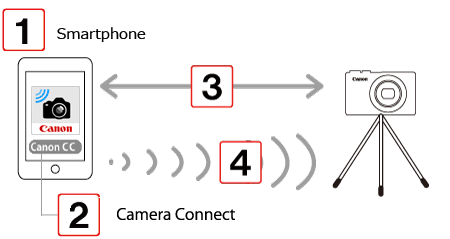
Step 1: Confirming the smartphone's OS version
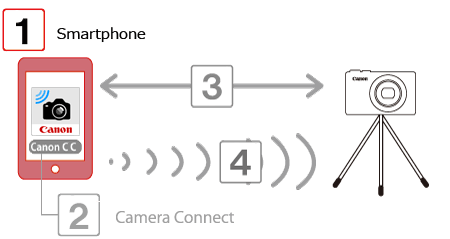
 1. Check the smartphone’s specifications.
1. Check the smartphone’s specifications.
To confirm the Android™ OS version information, check the [Settings] menu(

) ⋗ [About device] ⋗ [Android version].

Caution
Please refer to the related information for details on the smartphones which can be connected with a camera wirelessly.
Caution
Turning off the sleep function of the smartphone is recommended.
The setting procedures and items may differ depending on the Android™ OS version installed on your smartphone.
Step 2: Installing Camera Connect on the smartphone and setting Wi-Fi to ON

Caution
The example procedure is shown in Android™ OS 4.0.
The example screen images from the smartphone are used to explain the setting procedures and may differ from the screens shown on other models. For more information on the model you are using, refer to your smartphone’s instruction manual.
Caution
If Camera Connect is not yet installed on your Android™ smartphone (OS version 4.0 or higher) that supports NFC, touch the N-Mark (

) on the smartphone against the camera's N-Mark to make Google Play™ start automatically on the smartphone and to open the Camera Connect download screen.
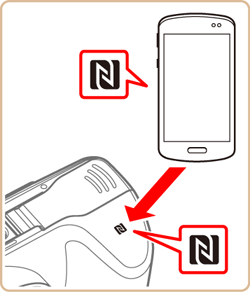
Using an NFC-compatible Android™ smartphone (OS version 4.0 or later) simplifies the process of connecting to the camera via NFC. When using Camera Connect for remote live view shooting, make sure that the camera is in [Shooting Mode] or in [Power OFF] mode before establishing the connection.
 1. Touch the [Play Store] application on your smartphone to access Google Play™.
1. Touch the [Play Store] application on your smartphone to access Google Play™.

Caution
The Camera Connect application is free, but separate connection charges for accessing Google Play™ may be applicable.
A Google account is necessary to download Camera Connect.
It is not possible to download Camera Connect to smartphones not equipped with GooglePlay™.
Downloading the application via a cellular network may take longer than downloading via Wi-Fi.
 2. Touch the search icon.
2. Touch the search icon.
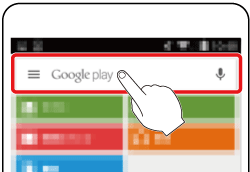
 4. Choose [Camera Connect] from the displayed search results, and install it on the smartphone.
4. Choose [Camera Connect] from the displayed search results, and install it on the smartphone.
After installation has been completed, tap the [Home] button to return to the Home Screen.
 5. Touch the menu key, and then touch [Settings] (
5. Touch the menu key, and then touch [Settings] (  ).
).
 6. Confirm that the smartphone is not set to [Airplane mode].
6. Confirm that the smartphone is not set to [Airplane mode].

 8. Secure the camera.
8. Secure the camera.
Once remote live view shooting begins, the camera lens comes out. Lens motion from zooming may also move the camera out of position. Keep the camera still by mounting it on a tripod or taking other measures.
Step 3: Connecting the camera to the smartphone
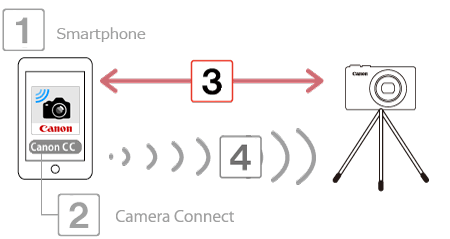
 1. Press the [
1. Press the [  ] button.
] button.
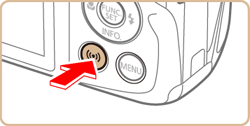
Caution
With the default settings, the device name is displayed.
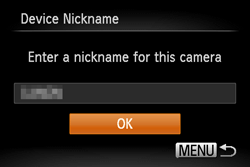
To change the camera’s nickname, press the [

], [

] buttons to choose the input field, press the [

] button to display the keyboard, and then enter the desired nickname. After you have finished entering the nickname, press the [ MENU ] button to return to the registration screen, press the [

], [

] buttons, choose [OK], and then press the [

] button.
This nickname will be displayed on [Select a Device] screen when connecting to other devices via Wi-Fi.
 4. The camera’s SSID and password are displayed.
4. The camera’s SSID and password are displayed.
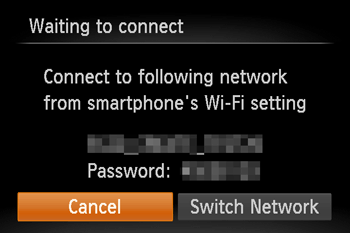
 5. In the smartphone’s Wi-Fi setting menu, choose the SSID (network name) displayed on the camera to establish a connection. In the password field, enter the password displayed on the camera.
5. In the smartphone’s Wi-Fi setting menu, choose the SSID (network name) displayed on the camera to establish a connection. In the password field, enter the password displayed on the camera.

After confirming that the smartphone and the camera are connected, touch the [Home Button] to return to the [Home Screen].
On the camera selection screen displayed on the smartphone, choose the camera to begin pairing.

 7. Press the [
7. Press the [  ], [
], [  ] buttons to select [Yes], and then press the [
] buttons to select [Yes], and then press the [  ] button.
] button.
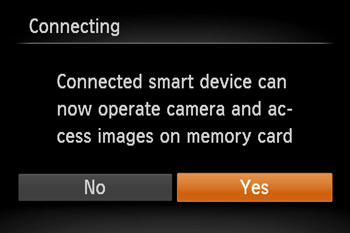
Caution
You can now use the smartphone for remote live view shooting, or to browse, transfer, or geotag images on the camera.
You can change privacy settings for registered smartphones.
 8. Once you have connected to the smartphone, a screen like the one below will appear.
8. Once you have connected to the smartphone, a screen like the one below will appear.
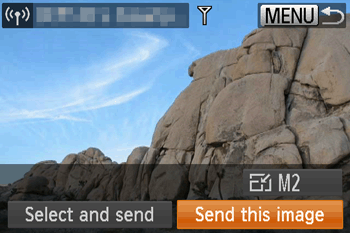
Caution
You can connect to smartphones that you have already connected to by choosing them on the [Select a Device] screen in step 3.
When you press the [

] button to open the Wi-Fi menu after the first time, recent destinations will be listed first when you access the Wi-Fi menu. You can easily connect again by pressing the [

] , [

] buttons to choose the device and then pressing the button [

]. To add a new device, display the device selection screen by pressing the [

] , [

] buttons and configure the setting. If you prefer not to display recent target devices, choose [MENU] ⋗ [

] tab ⋗ [Wireless settings] ⋗ [Wi-Fi Settings] ⋗ [Target History] ⋗ [Off].
To add multiple smartphones, repeat the procedures starting from "Step 2: Installing Camera Connect on the Smartphone and Setting Wi-Fi to ON".
Step 4 : Using the smartphone to control the camera during remote shooting

 1. In Camera Connect on the smartphone, choose [Remote live view shooting].
1. In Camera Connect on the smartphone, choose [Remote live view shooting].
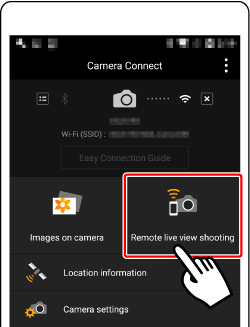
Caution
The camera lens will come out. Do not press near the lens, and make sure no objects will obstruct it.
 2. Once the camera is ready for remote live view shooting, a live image from the camera is displayed on the smartphone. At this time, a message is displayed on the camera, and all operations except pressing the power button are disabled.
2. Once the camera is ready for remote live view shooting, a live image from the camera is displayed on the smartphone. At this time, a message is displayed on the camera, and all operations except pressing the power button are disabled.
 3. Use the smartphone to control the camera. Press the
3. Use the smartphone to control the camera. Press the  button to shoot.
button to shoot.

Caution
Any rough subject motion shown on the smartphone due to the connection environment will not affect recorded images.
Captured images are not transferred to the smartphone. Use the smartphone to browse and import images from the camera.
*Android™, and Google Play™ are trademarks of Google Inc.
 icon, and camera setting procedures are indicated by the
icon, and camera setting procedures are indicated by the  icon.
icon.










 ) ⋗ [About device] ⋗ [Android version].
) ⋗ [About device] ⋗ [Android version].

 ) on the smartphone against the camera's N-Mark to make Google Play™ start automatically on the smartphone and to open the Camera Connect download screen.
) on the smartphone against the camera's N-Mark to make Google Play™ start automatically on the smartphone and to open the Camera Connect download screen.






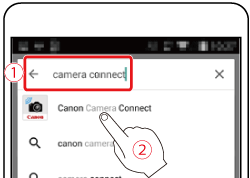














 ], [
], [  ] buttons to choose the input field, press the [
] buttons to choose the input field, press the [  ] button to display the keyboard, and then enter the desired nickname. After you have finished entering the nickname, press the [ MENU ] button to return to the registration screen, press the [
] button to display the keyboard, and then enter the desired nickname. After you have finished entering the nickname, press the [ MENU ] button to return to the registration screen, press the [  ], [
], [  ] buttons, choose [OK], and then press the [
] buttons, choose [OK], and then press the [  ] button.
] button.







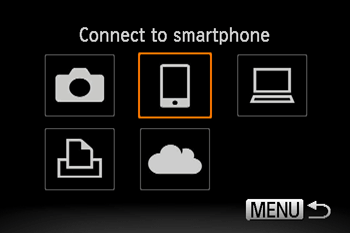




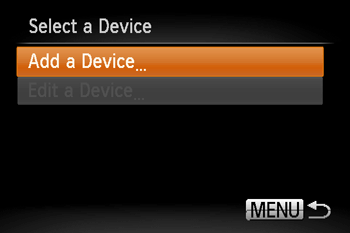















 ] button to open the Wi-Fi menu after the first time, recent destinations will be listed first when you access the Wi-Fi menu. You can easily connect again by pressing the [
] button to open the Wi-Fi menu after the first time, recent destinations will be listed first when you access the Wi-Fi menu. You can easily connect again by pressing the [  ] , [
] , [  ] buttons to choose the device and then pressing the button [
] buttons to choose the device and then pressing the button [  ]. To add a new device, display the device selection screen by pressing the [
]. To add a new device, display the device selection screen by pressing the [  ] , [
] , [  ] buttons and configure the setting. If you prefer not to display recent target devices, choose [MENU] ⋗ [
] buttons and configure the setting. If you prefer not to display recent target devices, choose [MENU] ⋗ [  ] tab ⋗ [Wireless settings] ⋗ [Wi-Fi Settings] ⋗ [Target History] ⋗ [Off].
] tab ⋗ [Wireless settings] ⋗ [Wi-Fi Settings] ⋗ [Target History] ⋗ [Off]. 













